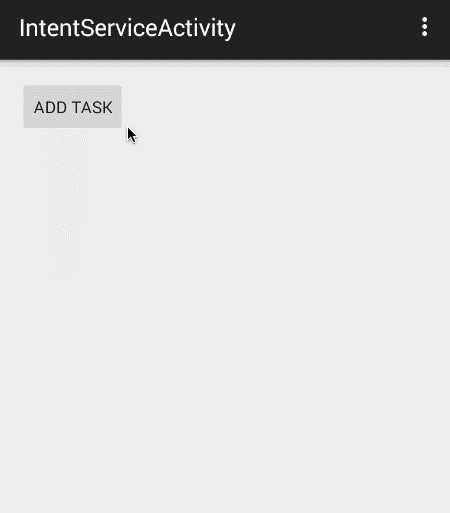标签:
大家都清楚,在Android的开发中,凡是遇到耗时的操作尽可能的会交给Service去做,比如我们上传多张图,上传的过程用户可能将应用置于后台,然后干别的去了,我们的Activity就很可能会被杀死,所以可以考虑将上传操作交给Service去做,如果担心Service被杀,还能通过设置startForeground(int, Notification)方法提升其优先级。
那么,在Service里面我们肯定不能直接进行耗时操作,一般都需要去开启子线程去做一些事情,自己去管理Service的生命周期以及子线程并非是个优雅的做法;好在Android给我们提供了一个类,叫做IntentService,我们看下注释。
IntentService is a base class for {@link Service}s that handle asynchronous
requests (expressed as {@link Intent}s) on demand. Clients send requests
through {@link android.content.Context#startService(Intent)} calls; the
service is started as needed, handles each Intent in turn using a worker
thread, and stops itself when it runs out of work.
意思说IntentService是一个基于Service的一个类,用来处理异步的请求。你可以通过startService(Intent)来提交请求,该Service会在需要的时候创建,当完成所有的任务以后自己关闭,且请求是在工作线程处理的。
这么说,我们使用了IntentService最起码有两个好处,一方面不需要自己去new Thread了;另一方面不需要考虑在什么时候关闭该Service了。
好了,那么接下来我们就来看一个完整的例子。
我们就来演示一个多个图片上传的案例,当然我们会模拟上传的耗时,毕竟我们的重心在IntentService的使用和源码解析上。
首先看下效果图
效果图

每当我们点击一次按钮,会将一个任务交给后台的Service去处理,后台的Service每处理完成一个请求就会反馈给Activity,然后Activity去更新UI。当所有的任务完成的时候,后台的Service会退出,不会占据任何内存。
Service
1 public class UploadImgService extends IntentService 2 { 3 private static final String ACTION_UPLOAD_IMG = "com.zhy.blogcodes.intentservice.action.UPLOAD_IMAGE"; 4 public static final String EXTRA_IMG_PATH = "com.zhy.blogcodes.intentservice.extra.IMG_PATH"; 5 6 public static void startUploadImg(Context context, String path) 7 { 8 Intent intent = new Intent(context, UploadImgService.class); 9 intent.setAction(ACTION_UPLOAD_IMG); 10 intent.putExtra(EXTRA_IMG_PATH, path); 11 context.startService(intent); 12 } 13 14 15 public UploadImgService() 16 { 17 super("UploadImgService"); 18 } 19 20 @Override 21 protected void onHandleIntent(Intent intent) 22 { 23 if (intent != null) 24 { 25 final String action = intent.getAction(); 26 if (ACTION_UPLOAD_IMG.equals(action)) 27 { 28 final String path = intent.getStringExtra(EXTRA_IMG_PATH); 29 handleUploadImg(path); 30 } 31 } 32 } 33 34 private void handleUploadImg(String path) 35 { 36 try 37 { 38 //模拟上传耗时 39 Thread.sleep(3000); 40 41 Intent intent = new Intent(IntentServiceActivity.UPLOAD_RESULT); 42 intent.putExtra(EXTRA_IMG_PATH, path); 43 sendBroadcast(intent); 44 45 } catch (InterruptedException e) 46 { 47 e.printStackTrace(); 48 } 49 50 51 } 52 53 @Override 54 public void onCreate() 55 { 56 super.onCreate(); 57 Log.e("TAG","onCreate"); 58 } 59 60 @Override 61 public void onDestroy() 62 { 63 super.onDestroy(); 64 Log.e("TAG","onDestroy"); 65 } 66 }
代码很短,主要就是继承IntentService,然后复写onHandleIntent方法,根据传入的intent来选择具体的操作。startUploadImg是我写的一个辅助方法,省的每次都去构建Intent,startService了。
Activity
1 public class IntentServiceActivity extends AppCompatActivity 2 { 3 4 public static final String UPLOAD_RESULT = "com.zhy.blogcodes.intentservice.UPLOAD_RESULT"; 5 6 private LinearLayout mLyTaskContainer; 7 8 private BroadcastReceiver uploadImgReceiver = new BroadcastReceiver() 9 { 10 @Override 11 public void onReceive(Context context, Intent intent) 12 { 13 if (intent.getAction() == UPLOAD_RESULT) 14 { 15 String path = intent.getStringExtra(UploadImgService.EXTRA_IMG_PATH); 16 17 handleResult(path); 18 19 } 20 21 } 22 }; 23 24 private void handleResult(String path) 25 { 26 TextView tv = (TextView) mLyTaskContainer.findViewWithTag(path); 27 tv.setText(path + " upload success ~~~ "); 28 } 29 30 31 @Override 32 protected void onCreate(Bundle savedInstanceState) 33 { 34 super.onCreate(savedInstanceState); 35 setContentView(R.layout.activity_intent_service); 36 37 mLyTaskContainer = (LinearLayout) findViewById(R.id.id_ll_taskcontainer); 38 39 registerReceiver(); 40 } 41 42 private void registerReceiver() 43 { 44 IntentFilter filter = new IntentFilter(); 45 filter.addAction(UPLOAD_RESULT); 46 registerReceiver(uploadImgReceiver, filter); 47 } 48 49 int i = 0; 50 51 public void addTask(View view) 52 { 53 //模拟路径 54 String path = "/sdcard/imgs/" + (++i) + ".png"; 55 UploadImgService.startUploadImg(this, path); 56 57 TextView tv = new TextView(this); 58 mLyTaskContainer.addView(tv); 59 tv.setText(path + " is uploading ..."); 60 tv.setTag(path); 61 } 62 63 64 @Override 65 protected void onDestroy() 66 { 67 super.onDestroy(); 68 unregisterReceiver(uploadImgReceiver); 69 } 70 }
Activity中,每当我点击一次按钮调用addTask,就回模拟创建一个任务,然后交给IntentService去处理。
注意,当Service的每个任务完成的时候,会发送一个广播,我们在Activity的onCreate和onDestroy里面分别注册和解注册了广播;当收到广播则更新指定的UI。
这样我们就完成了我们的效果图的需求;通过上例,大家可以看到我们可以使用IntentService非常方便的处理后台任务,屏蔽了诸多细节;而Service与Activity通信呢,我们选择了广播的方式(当然这里也可以使用LocalBroadcastManager)。
学会了使用之后,我们再一鼓作气的看看其内部的实现。
直接看IntentService源码
1 /* 2 * Copyright (C) 2008 The Android Open Source Project 3 * 4 * Licensed under the Apache License, Version 2.0 (the "License"); 5 * you may not use this file except in compliance with the License. 6 * You may obtain a copy of the License at 7 * 8 * http://www.apache.org/licenses/LICENSE-2.0 9 * 10 * Unless required by applicable law or agreed to in writing, software 11 * distributed under the License is distributed on an "AS IS" BASIS, 12 * WITHOUT WARRANTIES OR CONDITIONS OF ANY KIND, either express or implied. 13 * See the License for the specific language governing permissions and 14 * limitations under the License. 15 */ 16 17 package android.app; 18 19 import android.content.Intent; 20 import android.os.Handler; 21 import android.os.HandlerThread; 22 import android.os.IBinder; 23 import android.os.Looper; 24 import android.os.Message; 25 26 27 public abstract class IntentService extends Service { 28 private volatile Looper mServiceLooper; 29 private volatile ServiceHandler mServiceHandler; 30 private String mName; 31 private boolean mRedelivery; 32 33 private final class ServiceHandler extends Handler { 34 public ServiceHandler(Looper looper) { 35 super(looper); 36 } 37 38 @Override 39 public void handleMessage(Message msg) { 40 onHandleIntent((Intent)msg.obj); 41 stopSelf(msg.arg1); 42 } 43 } 44 45 46 public IntentService(String name) { 47 super(); 48 mName = name; 49 } 50 51 52 public void setIntentRedelivery(boolean enabled) { 53 mRedelivery = enabled; 54 } 55 56 @Override 57 public void onCreate() { 58 super.onCreate(); 59 HandlerThread thread = new HandlerThread("IntentService[" + mName + "]"); 60 thread.start(); 61 62 mServiceLooper = thread.getLooper(); 63 mServiceHandler = new ServiceHandler(mServiceLooper); 64 } 65 66 @Override 67 public void onStart(Intent intent, int startId) { 68 Message msg = mServiceHandler.obtainMessage(); 69 msg.arg1 = startId; 70 msg.obj = intent; 71 mServiceHandler.sendMessage(msg); 72 } 73 74 75 @Override 76 public int onStartCommand(Intent intent, int flags, int startId) { 77 onStart(intent, startId); 78 return mRedelivery ? START_REDELIVER_INTENT : START_NOT_STICKY; 79 } 80 81 @Override 82 public void onDestroy() { 83 mServiceLooper.quit(); 84 } 85 86 87 @Override 88 public IBinder onBind(Intent intent) { 89 return null; 90 } 91 92 93 protected abstract void onHandleIntent(Intent intent); 94 }
可以看到它在onCreate里面初始化了一个HandlerThread,
转载标明出处:
http://blog.csdn.net/lmj623565791/article/details/47143563;
就是每次调用onStartCommand的时候,通过mServiceHandler发送一个消息,消息中包含我们的intent。然后在该mServiceHandler的handleMessage中去回调onHandleIntent(intent);就可以了。
那么我们具体看一下源码,果然是这样,onStartCommand中回调了onStart,onStart中通过mServiceHandler发送消息到该handler的handleMessage中去。最后handleMessage中回调onHandleIntent(intent)。
注意下:回调完成后回调用 stopSelf(msg.arg1),注意这个msg.arg1是个int值,相当于一个请求的唯一标识。每发送一个请求,会生成一个唯一的标识,然后将请求放入队列,当全部执行完成(最后一个请求也就相当于getLastStartId == startId),或者当前发送的标识是最近发出的那一个(getLastStartId == startId),则会销毁我们的Service.
如果传入的是-1则直接销毁。
那么,当任务完成销毁Service回调onDestory,可以看到在onDestroy中释放了我们的Looper:mServiceLooper.quit()。
ok~ 如果你的需求可以使用IntentService来做,可以尽可能的使用,设计的还是相当赞的。当然了,如果你需要考虑并发等等需求,那么可能需要自己去扩展创建线程池等。
Android IntentService完全解析 当Service遇到Handler
标签:
原文地址:http://www.cnblogs.com/itpepe/p/4765119.html